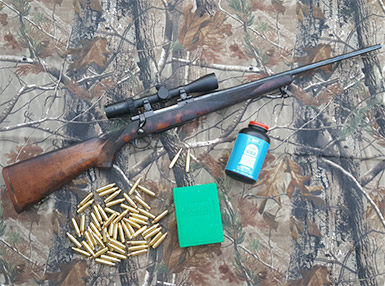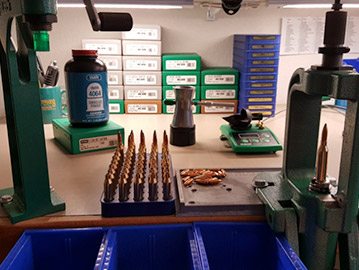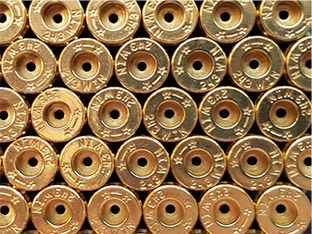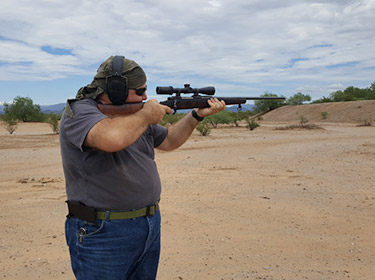
240 Page Super Pouper? Oh Yea, the .243 Winchester!

This Ruger M77 in .243 Winchester has been on multiple hunts and one house fire and besides adding some character to the stock, it still shoots and operates like it was new.
When I was ten years old my sister took me to watch the first Star Wars movie. Since that time, I’ve seen every subsequent movie on the big screen. Now I understand that these are science fiction movies and they don’t seem to have a lot to do with the .243 Winchester, but hear me out. In the second movie, “The Empire Strikes Back,” Luke Skywalker goes to visit Yoda in the Swamps of Dagobah and in one scene Luke insults Yoda about his size, in which Yoda replies, “Size matters not, look at me, judge me by my size do you?” In our super-sized society, bigger always seems to be better and we tend to underestimate the smaller things in life.
Don’t judge the .243 by the size of its bullet because it’s a warhead attached to a rocket body and capable of speeds in excess of 4,000 fps and effective to around 200 yards. So, let’s run with that by simply stating that it would be very plausible to hunt everything up to and including deer with a .243 Winchester. Of course, with everything in life, there are realistic limitations and the use of a .243 Winchester on larger game requires accurate shot placement at closer ranges with the correct bullet. All these factors are the precursor to a successful hunt and when you put it all into practice, the results will fill the freezer.
From my research in military and hunting calibers, the 50’s were a great period for cartridge innovations. It was around this time shooters were introduced to a wildcat cartridge created by the Ex-Editor of Field and Stream Magazine and benchrest shooter Warren Page. Story has it that Warren came into possession of some then-prototype 7.62x51mm cases that were being developed for use by the U.S. Military and added his own unique modifications. He necked the case down to accept .24 caliber bullets and christened it the 240 Page Super Pouper. (Yep, you heard that right. Also, commonly but incorrectly referred to as the 240 Page Super Pooper.) Page wanted a cartridge that could not only handle varmints, but medium size game such as deer by employing different weight bullets. This gave the .243 great versatility, “a word I’m very fond of in the selection of firearms or calibers,” to the cartridge that delivered on its intended purpose.
The Page Super Pouper was introduced to the public in 1955 under the Winchester banner. It was renamed the .243 Winchester and chambered in the Winchester Model 70 bolt-action and Model 88 lever-action sporting rifles. The .243 Winchester’s light recoil is a plus for shooters who are susceptible to recoil sensitivity. Handloading the .243 Win allows you to take advantage of the caliber’s versatility by customizing your loads. Reducing or increasing the powder charge and bullet weight allows you to meet your hunting and shooting needs with minimal recoil as the result.

Handloading or making your own ammunition is a labor of love and a very satisfying hobby, especially when you get to shoot the end result and then reload it again for the next shooting session.
Now whether you’re new to manufacturing your own ammunition or a diehard veteran, it can save you money, “IF,” you do it wisely. This skill is all about feel and I understand that puzzled look on your face. Don’t worry, you’ll eventually understand when you get your hands dirty. Starline Brass prides themselves on making the finest brass on the market, so your new cases come ready to load out of the box. I’ve been using their brass for a number of years and unless they don’t currently manufacture the case I need, they’re my only choice in new brass. In most cases you need to only size down to the bullet’s seating depth. If full length sizing is required, it will be noted and currently the only Starline Brass that requires full length sizing is .454 Casull, .458 SOCOM, and some .45 Colt, and that depends on the bullet diameter used.
Starline has been adding new brass at a rapid rate and if you don’t see it, just wait, it could be in my next article. But for now, you can feed your .243 Winchester with Starline Brass.
One of the greatest things about making your own ammo is that you never run out of ammunition. Every loading manual should have the complete case specifications for a loaded and/or unloaded case. A great rule of thumb in making ammunition is, “Safety is paramount. If you’re not sure, don’t do it till you have the correct information.” If you have a friend who is a practiced loader, tap their knowledge and experience. If you are starting from scratch, then read up on the subject (reloading manuals are a great source) or call RCBS, as they will be happy to help you any way they can.
Loading for a bolt action rifle requires a normal full-length two die set consisting of a full-length sizer die with an expander-decapping unit, and a seater die with a bullet seater plug. With semi-automatics like the Browning BAR MK3, MSR, lever action and pump action rifles, you may have to use a small base, two die set, consisting of a small base sizer with an expander-decapping unit and a regular seater die with a seater plug. The sizer die resizes cases below SAAMI minimums, reducing the shoulder and body by a few thousandths of an inch; assuring proper functioning in these tighter chambers.
Maximum Case Length: 2.045”
Trim-To-Length: 2.035”
Max OAL (Over All Length): 2.710”
RCBS Shell Holder: #3
RCBS Pilot Caliber: #24
RCBS Collet: #1
Primer: Large Rifle
SAAMI Limit: 52,000 CUP (Copper Units of Pressure), or 60,000 PSI
Always lube your cases for use in all non-carbide dies.
Trimming your .243 cases may be necessary even after one firing depending on the brass and how hot the load was. There are many case trimmers on the market to choose from and I prefer the RCBS Trim Pro 2 Manual Case Trimmer mounted on a RCBS Case Trimmer Stand powered by my cordless drill. The Trim Pro uses a spring-loaded universal shell holder that accommodates cases with .250-inch to .625-inch rims and standard caliber specific pilots. The stand holds two spare cutter heads and 18 pilots as well as 5 shell holders for the original trimmer. With practice, you can process several hundred cases in a short amount of time and time is precious in the process of making your own ammo.
| BULLET WT. / MFR & TYPE: | POWDER: | AV:(FPS) | SD: |
| 80 gr. SBT | 38.7 grs. RE-15 | 3107.6 | 70.1 |
| 80 gr. SBT | 33.5 grs. IMR4064 | 2751.1 | 28.6 |
| 100 gr. SPT | 32.0 grs. IMR4064 | 2577.1 | 15.0 |
| 100 gr. SPT | 35.5 grs. H380 | 2656.4 | 34.8 |
Notes: Velocity figures are derived from a ten-round average recorded on a Caldwell Ballistic Precision Chronograph G2 placed 15 feet from the muzzle. Starline’s .243 Winchester brass was used for this article. Abbreviations: (AV): Average Velocity (SD): Standard Deviation
The author Norman Gray chronographing his .243 Winchester loads deep in the Arizona desert in the middle of summer. It was only 104 degrees that day.
I handloaded my cases using formulas from the Sierra Loading Manual 5th Edition. I used the max charge recommendations for every load to see what the standard deviation would be in this particular Ruger M77 rifle. As you can see, the standard deviations were different in each load and this is because each bullet will interact with the barrel’s lands and grooves differently. The end goal is to formulate a load that will give you the lowest SD possible. This is your indication that the rifle likes the load and your accuracy will be maximized whether on the range or in the field. It takes time and experience to understand these principles, but if you’re a person who loves a challenge and figuring things out, you will have a lot of fun and a great sense of accomplishment.
Contributors:
Starline Brass: (660) 826-6640 www.starlinebrass.com
RCBS: (800) 379-1732 www.rcbs.com
DISCLAIMER: All reloading data in this article is for informational purposes only. Starline Brass and the author accept no responsibility for use of the data in this article.